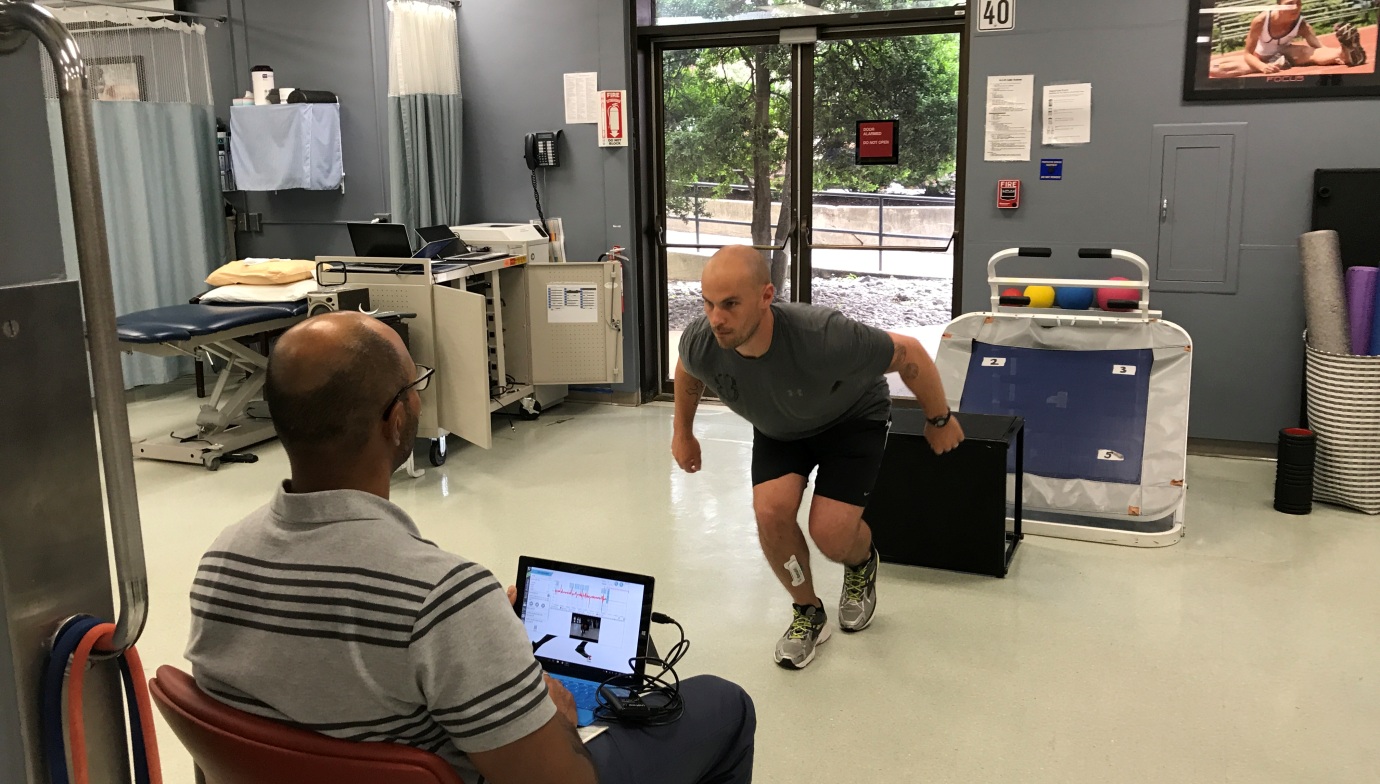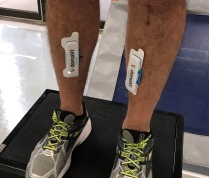Wearable Devices Track Sports Injuries, Provide Hard Data for Recovery Plans

(Washington, D.C.,) When Georgetown MBA student Andy Bird, 31 tore his left ACL playing basketball in November 2016, he expected a traditional course of physical therapy to get back to his active life after surgery.
Then about three months into his PT treatment plan, Bird’s physical therapist Sameer Mehta began using a new technology called dorsaVi™ that provides hard numbers for the body’s twists, turns, angles, symmetry, speed and G force - all measurements that have directed Bird’s care and treatment.
“This device gives us more objective measures in this area of healthcare that is perhaps sometimes too subjective,” says Sameer Mehta PT, DPT, SCS, CSCS, clinical supervisor of Outpatient Physical Therapy at MedStar Georgetown University Hospital.
The result is a prescription plan based on numbers and hard data, not the trained eye of the PT, alone.

“To really make appropriate data-driven decisions about someone’s health and give recommendations and a treatment plan for their activity, this technology gives us more real, true measurements. We can answer questions like, ‘do we get this person to run now or do we wait until later? How fast? Do they need more rest? And, for example, is it an old injury of the left ankle causing the right knee to swell up? Or is the swelling truly a new injury caused by a previous one? ’ ”
“I thought the dorsaVi definitely helped, especially as I progressed along in my recovery and my therapy,” says Bird. “Being able to see how I ran, how I moved, how I jumped in hard numbers was really important. I have seen the evidence of what I need to do to get better, faster.”
The dorsaVi technology consists of two three-inch wearable sensors that are wirelessly applied to the patient’s shins or back. The sensors pair with a radio frequency device via ANT technology, similar to Bluetooth, to then communicate with software on a Microsoft Surface tablet, capturing real-time data. The measurements are uploaded into the software that formulates instant charts and graphs for the physical therapist to analyze.
During a recent physical therapy session with Mehta, Bird’s data showed something unexpected.
“Based on the tests I had today, I see that I need to be as equally focused and diligent about working on my non-injured leg as I am with the injured leg and I don’t think I would have been able to see that without this system,” says Bird.
to see that without this system,” says Bird.
“Andy’s tests showed that he has been working really hard on this injured leg, but now his good leg is experiencing some weakness that is causing asymmetry and imbalance between the two,” says Mehta. “From here I’m giving him exercises to increase the strength of his good leg. Asymmetry is something that would be very difficult for me to capture unless I had some other really expensive and big equipment.”
DorsaVi can also be used remotely or on the playing field to gather more information that could be related to their pain during an actual run or sport-specific activity.
“I can fit my patient with the sensors, send them out on their run and when they feel pain, they hit a button. The software will then show me what the patient was doing when they experienced the pain,” says Mehta. “From there I can adjust my treatment plan accordingly.”
A second set of sensors can also help determine the source of back, shoulder or neck pain.
“The same set of sensors along with two surface EMGs placed on the back muscles can give you objective data on movement of the spine along with muscle activation,” says Mehta. “One can also perform a monitoring session to assess movement patterns at work or home where the patient wears the sensors on the back throughout the day. The sensors record human movement, posture, and other analytical information that give physical therapists real numbers related to their day-to-day movement patterns. Ultimately this helps guide the recovery or even assists in steering the patient down another pathway to healing.”
The dorsaVi technology is now being used by a number of professional sports teams to help with rehabilitation and to make decisions about whether or not athletes should return to the field.
“This is the wave of the future,” says Mehta. “Using this technology expedites a patient’s recovery because as a practitioner I’m getting concrete data that can then give me actionable information for me to drive change.”
“I think the technology is incredibly important,” says Bird. “In sports and physicality and stamina, we often go with our gut, but having the technology to back that up really reinforces the science and the progression of the whole patient experience. By the fall I hope to be back on the basketball court, running triathlons and keeping up with my goals.”
DorsaVi is available at MedStar Georgetown and at MedStar Health at MedStar Health at Lafayette Centre in downtown Washington, D.C.,
Categories
Media Contact
Marianne Worley
Director of Media Relations
Office: 703-558-1287Pager: 202-405-2824
worleym@gunet.georgetown.edu









